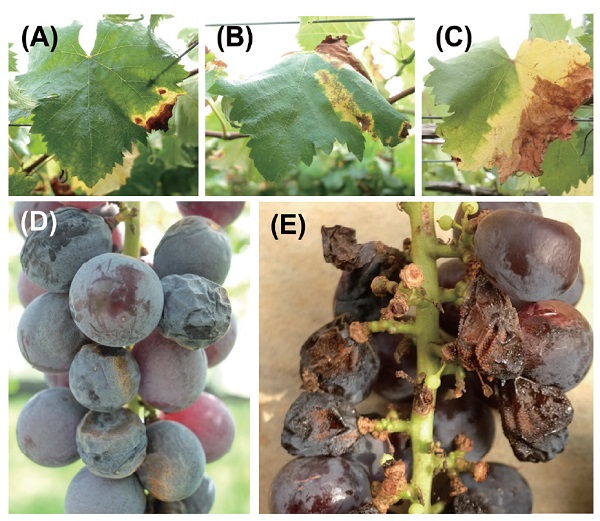All issues

Author:Chu-Ping Lin*, Chih-Li Wang, Jyh-Nong Tsai, Yu-Lun Dai, Pao-Jan Ann, Yue-Mei Zhan, and Shun-Yuan Huang
Abstract:
Grape ripe rot caused by Colletotrichum spp. is one of the most devastating diseases for grape production in Taiwan. To reveal population structures, phylogenetic relationships, symptoms, and geographic distribution of the causal organisms in the field, grape samples with the typical ripe rot symptoms on fruits, and necrotic lesions on twigs and leaves were collected and investigated. Moreover, symptoms from field samples and inoculated plants were also recorded. From 2012 to 2020, a total of 40 Colletotrichum isolates were isolated and identified with the phylogenetic analysis based on the concatenated sequences of internal transcribed spacer (ITS), lyceraldehyde-3-phosphatedehydrogenase (GAPDH), actin (ACT), beta-tubulin 2 (TUB2), and chitin synthase 1 (CHS-1) genes. The phylogenetic tree showed that grape ripe rot in Taiwan was mainly caused by Colletotrichum viniferum, which was divided into two subclades, subclade T and subclade C. Among 28 isolates that were isolated from diseased fruits of grape ripe rot, 85.7% of these isolates belonged to C. viniferum subclade T, 3.6% to C. viniferum subclade C, 7.1% to Colletotrichum fructicola, and 3.6% to Colletotrichum tropicale. The results also showed that C. viniferum subclade T could be isolated not only from diseased fruits but also from symptomatic leaves. The pathogens are distributed in most major grape-growing areas, including Zhuolan in Miaoli County, Xinshe and Wufeng in Taichung City, Dacun in Changhua County, and Xinyi, Guoxing, Shuili and Puli in Nantou County. When inoculated on young fruits in planta in the field, the isolates of C. viniferum subclade T induced the typical ripe rot symptoms on grapefruits after veraison, suggesting that the pathogens were able to establish a latent infection. When inoculated on whole potted plants in a greenhouse, isolates of C. viniferum subclade T caused various symptoms on leave, such as necrotic lesions with a large area of yellow halo on the leave margin, defoliation, and browning leaf veins. Furthermore, necrosis on shoots and blossoms was also observed. The results from field investigations and artificial inoculations indicate that the isolates of C. viniferum subclade T could cause various symptoms on fruits, leaves, shoots, and blossoms of grapes.
Key words:Subclade, Foliar symptoms, Multilocus phylogeny
Download:![]() PDF Links
PDF Links
- 1. Development of Tractor-Mounted Seedling Transplanter for Sweet Potato
- 2. Synergistic Effect of Additional Gas on the Toxicity of Phosphine to Sitophilus oryzae and Sitophilus zeamais (Coleoptera: Dryophthoridae)
- 3. Effects of Temperature and Solar Radiation on Growth Traits and Plant Elements in Purple Leafy Sweet Potato
 Submit your manuscript
Submit your manuscript
 Guide for authors
Guide for authors